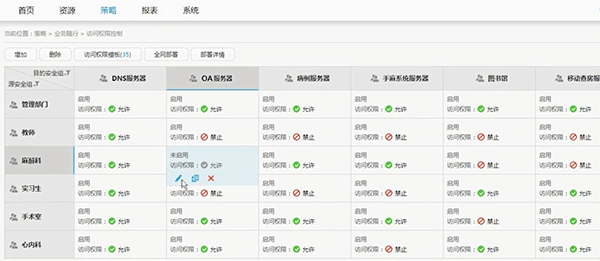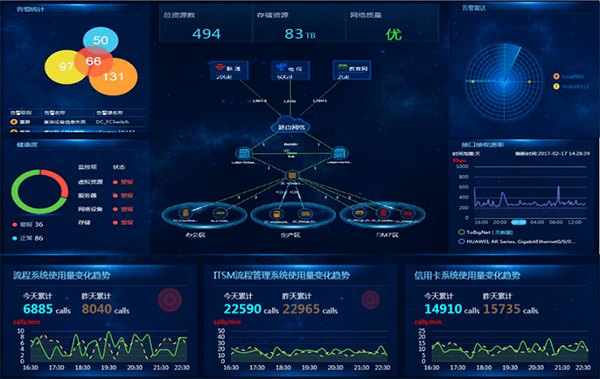Digital Hospital Network
Hospitals are currently facing problems such as diversification of access services, complexity of scenarios, and disappearance of network boundaries, and traditional network solutions can no longer meet the requirements of digital hospitals in the new era. To this end, Huawei has launched a digital hospital network solution that contains three important components: a smart brain, a robust limb, and a secure immune system.
- Intelligent Brain: Responding to Complex Access Scenarios and Providing Fine-grained Controls Hospital access scenarios are becoming more complex, and intelligent access control for different access scenarios is required to further allocate suitable network resources, which requires hospital networks to have a smart brain. Huawei provides an intelligent brain based on SDN (software-defined networking), which realizes the network's fine-grained situational awareness of services, intelligently allocates network and security resources, and responds to complex hospital access scenarios.
- Robust Limbs: Responding to Business Management Innovation and Delivering High-Quality Cloud Networks As the bearing foundation of the entire hospital's informationization, the network system is like a human limb, and a robust limb can support the development of various innovative applications. Huawei provides hospitals with a highly reliable network system that supports cloud computing services, mobile computing, and other services.medical carebusiness, easy to operate and maintain network systems.
- Immunization of security: responding to the borderlessness of the network and providing immunization of security across the network The health of the human body relies on a strong immune system, and hospitals need a similar system that can provide security situational awareness and control for the entire hospital. On the one hand, traditional security solutions are essential, and on the other hand, Huawei provides network-wide security co-defense functions to achieve security immunity for hospital network systems.
Client Background
A hospital is a Top5 large-scale general tertiary hospital in China, with 36 clinical departments, 17 medical and technical departments and 6 research institutes; there are 60 wards and 1,500 beds in total. The average daily outpatient volume is nearly 7,000, with more than 45,000 patients admitted and nearly 20,000 surgeries performed annually. With such a large-scale business and data volume, a reliable, stable, advanced, secure and easy-to-operate and maintain network system is particularly important for NUH.
A hospital understands the importance of information construction, through the network construction to link internal production, management and decision-making activities, rational allocation of hospital resources, optimization of production factors, combined with the application of new technologies such as mobile healthcare and lightweight SDN, which greatly facilitates the improvement of the hospital's level of production and productivity, and then improves the efficiency of the hospital's services and medical standards.
Operational challenges
Traditional hospital campus network construction, mostly using the construction mode of physical isolation of three sets of networks, such as intranet, extranet, and intelligent special network, can meet the hospital's needs for interconnection andnetwork securityDemand. With the emergence of new business demand models such as Internet healthcare, telemedicine, and medical Internet of Things, the traditional physical isolation of the network architecture has become a technical barrier to the launch of new services, resulting in fragmented data silos and the inability to achieve interoperability. At the same time, the equipment utilization caused by physical isolation, operation and maintenance management work is heavy, so that hospital managers have no time to focus on business innovation.
Urgent need to open up business data channels
- A hospital provides Internet+ healthcare services such as appointment booking and online consultation, which requires interoperability between the hospital's intranet and extranet;
- The development of telemedicine and hierarchical diagnosis and treatment requires the opening up of in-hospital and out-of-hospital networks, so that doctors and leaders can access voice and video conferencing at any time outside the hospital through the extranet;
- Medical IoT applications such as mobile care, asset management, personnel management, etc. need to connect the hospital intranet and the access control and monitoring services in the intelligent private network to complete the business linkage;
- The opening of the mobile Internet service of the palm hospital requires the opening up of the hospital's wireless network to the internal and external networks, and the development of mobile payment, online registration, and report inquiry.Need to ensure network and data security
- With unified network management software that integrates wired, wireless, server, storage and other infrastructure management, you can keep abreast of the health of your hospital's business, network usage, alerts, and risk prediction;
- Peking University Hospital integrates medical treatment and teaching, and the users of the hospital network have various roles such as medical staff, administrators, students, visitors, etc. The hospital needs role-based minimum authorization, and at the same time sets the expiration date according to the needs of the configuration, and automatically deletes it when the user leaves, avoiding redundant configurations brought by long-term operation and maintenance;
Striving for innovation in service models
- We hope to use BYOD technology innovatively to serve the healthcare business, enhance work efficiency, and meet the business needs of mobile check-in, mobile PACS, mobile office, Internet business and continuing education;
- Building integrated, multi-layered, and all-encompassing three-dimensional protection against wireless network threats and medical data leakage.
prescriptionSimplify - Triple Play

The wired wireless network construction of a hospital adopts the construction mode of three-network convergence, simplifies the complexity, and carries the intranet, extranet, and wireless network through a set of physical equipment, simplifies the network structure, and effectively avoids the heavy workload of operation and maintenance management of multiple sets of networks and the data silos brought about by the fragmentation of business systems. The logical isolation construction mode meets the construction requirements of hospital level protection, and ensures the security of medical services and data by cooperating with the hospital level protection construction.
Adopting Huawei's flagship campus core switch S12700 to take on the load of three networks, it improves the utilization efficiency of the equipment, reduces the million-dollar investment in the construction of network equipment, and lowers the energy consumption of the information technology system, bringing long-lasting economic and environmental benefits. The AC function can be realized by inserting ENP veneer into the Agile Switch. After AC function is integrated in Agile switch, wired and wireless can be unified in Agile switch for management, authentication and policy control, realizing real wired-wireless in-depth fusion and avoiding problems such as difficult management, troubleshooting and bottleneck of wireless forwarding performance caused by wired-wireless network fragmentation.
Simplify to make it easy - Agile Networks

With the demand for BYOD in hospitals, traditional network technology has complicated configuration and management of mobile terminal-based privilege control and experience assurance. VLANs and ACLs in traditional NAC technology still need to be configured in advance on the authentication point switch, and there is a great deal of deployment and maintenance workload. When changes to the configuration are required, it is a great burden for hospital network administrators.
Huawei introduced a lightweight campus SDN solution that utilizes the Agile Controller-Campus Campus Policy Controller to centrally control a variety of policies such as permissions, applications, bandwidth, QoS, and security across the entire network, realizing unified access and management for healthcare workers, managers, visitors, equipment administrators, and dumb terminals to safeguard users' freedom of mobility and business experience.
The matrix strategy matrix reduces the difficulty of network-wide strategy planning; graphical/drag-and-drop operation improves the efficiency of network O&M; WYSIWYG Portal editor and rich system templates allow marketing advertisements to go online quickly and simplify the O&M workload of more than 80%.
Make it easy - Integration Management

Huawei eSight, as the unified management platform for network operation and maintenance of NUH, completes the boring command line with graphical drag-and-drop operation and maintenance through an affable operation and management interface.
Provides storage, servers, applications, switches, routers,firewallsIt supports unified management of WLAN, server room facilities, PON networks, wireless broadband trunking equipment, video surveillance, IP phones, video equipment, etc. It supports unified view, resources, topology, faults, performance, and intelligent configuration of multi-vendor equipment, and at the same time, it provides customers with customization capability of third-party equipment and northbound interfaces of alerts, which can help customers to build their own unified management system, reduce operation and maintenance costs, and improve operation and maintenance efficiency. This helps customers to build their own unified management system, reduce operation and maintenance costs, and improve operation and maintenance efficiency.
- Customized large screen: drag-and-drop layout, easy for you to customize, real-time presentation of the latest business status, to help you quickly understand the key business indicators across the network;
- Business health monitoring: Provides the function of customizing topology view, O&M personnel can customize the topology view based on multiple dimensions, and prioritize the protection of core business and normal operation of core equipment;
- 360-degree mobile management: When the operation and maintenance personnel are outside the hospital, they can visualize the detection of key indicators and deal with network faults through mobile terminals. Search according to the user who reported the fault, quickly locate the cause of the fault, give optimization suggestions, and check the user log to confirm whether the problem has been solved.
Transforming Fun into Tao - Moderate Innovation

There are numerous innovative technologies and businesses in information technology construction, such as mobile healthcare and medical Internet of Things (IoT). Peking University Hospital became the first hospital to utilize BYOD in its medical business by comprehensively examining the maturity, security, and practicality of the technology. Huawei's indoor full-coverage wireless network carries services such as mobile medical care, mobile PACS, unified communications, remote teaching, and remote consultation. The wireless network carries mobile terminals, special carts, and high-definition video images from the operating room, which can be accessed through remote audio and video communication in any network environment within or outside the hospital, realizing the functions of remote audio and video communication and sharing desktop data.
Taking advantage of BYOD, doctors at Beida Hospital use tablets to quickly access medical records and give medical instructions at the patient's bedside, greatly improving the efficiency and quality of room visits and increasing patient satisfaction. Combined with hierarchical protection construction and Huawei's mobile sandbox technology, the hospital's data is saved to the encrypted area of the mobile terminal, and when the mobile device is lost, the data can be erased remotely, preventing the risk of data leakage.


